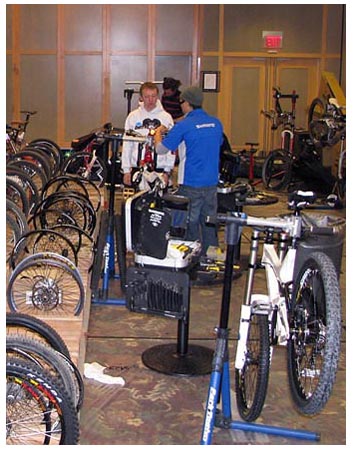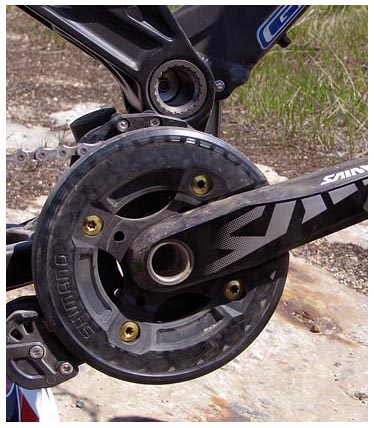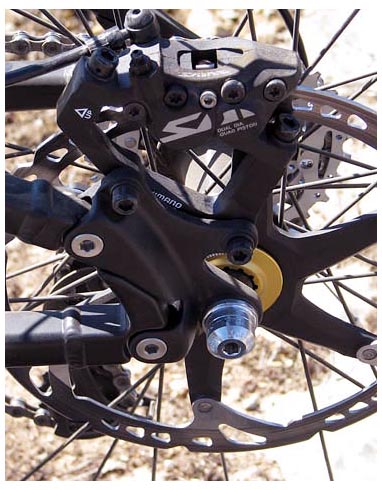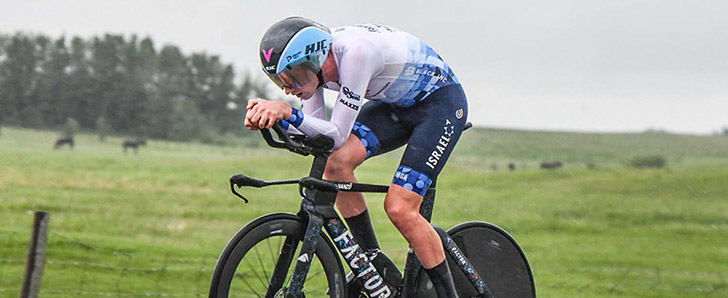June 28/08 3:28 am - Preview: New Shimano Saint Group for 2009
Posted by Editoress on 06/28/08
New Shimano Saint Group for 2009
Report by Mike Badyk made possible through the assistance of Shimano Canada
Back in July 2003 Rob and I were covering the Canadian National Championships at Whistler. Coinciding with the race was the initial release of the Shimano Saint group, Shimano's first foray into the DH and Freeride market. The initial review of Saint is still available through the Daily News Archive (see July 17/03).
It was quite favourable overall. We had a chance to ride it, of course, and we came away impressed with the burly, durable group. I had a chance to do long term testing on the Saint group, thanks to the extended loan of a very nice full suspension bike from Devinci. Again, the results were positive. The cranks in particular were awesome. The rest of the group was completely trouble free despite some serious bashing.
So, what's happened to Saint since 2003? Up until now, there haven't been any changes to it. It's out there in the market, but you don't see it that often as an entire group. The cranks are very popular but, beyond that, I can't honestly say that I have encountered Saint that often. I'm not completely sure what the story is. Expensive? Heavy? All of the above? The market is often fickle. Whatever it is, or was, Shimano wants to be well represented in all aspects of the cycling world and, like all companies, they want their products to succeed.
Since we had been at the original release event, Canadian Cyclist was invited back to Whistler to review the new Saint. With Rob in Europe covering races it was left to me to return to the world's most important mountain bike park at Whistler. Such hardship! Keep in mind that Shimano had the choice of going anywhere in the world to debut the new Saint, but they chose Whistler. Journalists and Shimano distributors from all over the world converged on Whistler to get the low down on it. Shimano folks from Japan, U.S.A and Canada made it all happen.
In what I consider to be a very smart move we were asked to ship a frame and fork to Shimano Canada which would then be sent out to Whistler. This way we got a chance to build up a bike from scratch. I've always found that wrenching with the parts or the bike gives you a pretty good idea of how everything functions even before you get to ride it.
I sent out a GT I-DRIVE 5 frame (140mm travel) with one of the most versatile and dependable forks I've ever ridden; the Manitou Sherman Firefly fork (20mm through axle, 130mm travel). I had a suspicion that just about everyone was going to have a mega-travel bike and I wanted to try something a bit different.
I'm still intrigued by the concept of the "all mountain" bike. Way back in the 80's it was always a mythical goal to have that one bike that would do just about everything. In other words, you need only one bike in your stable for cross country racing and technical trails with moderate jumps. Well, we are one heck of a lot closer to that elusive goal than we've ever been before. A bike with 5 or 6 inches of travel both front and rear, and yet light enough to get up a long hill has become very common in most manufacturers' lines.
When I arrived at the Westin Whistler, one of the ballrooms had been turned into a major workshop with tens of thousands of dollars of bikes, and boxes and boxes of Saint components. I found a work stand and got busy assembling my bike with a feeling like a kid at Christmas. First impression is going to be based on aesthetics and they seem to have a winner here. You can't go wrong with a gloss black finish especially when it has anodized gold highlights here and there. It would be difficult to have this clash with any colour of frame. Shimano did this many years ago with a limited edition LX group and I can't think of a much more attractive colour combo for a mountain bike. It's techno but it has some bling too.
My standard starting point for a build is the crank. I was hoping to test a Saint double but, unfortunately, they just weren't available for our test. Instead a single chainring was used along with a fine eThirteen chain guide. The crank was noticeably lighter than the previous version, yet according to Shimano it is considerably stronger and stiffer.
That is going to be a continuing theme for the new Saint. It is much lighter. The trend for the DH racers the last couple of years has been to go as light as possible. Although the original Saint was very strong, it did have a fair amount of beef to it. Not so with the new parts. The Hollowtech II technology (axle attached to the spider) is retained. I'm glad that it doesn't include the very fussy bearing load adjuster that is found on XTR. The BB cups are longer so they gain some strength. BB widths accommodated are 68, 73 and 83mm. You have a choice of 34/36/38/40/42 tooth rings with the single. Even something as simple as the resin bashguard is tweaked. This time it is honeycombed in the interior, which offers more impact resistance while shaving weight. If you get a double you get a 36/22 combo in a compact drive. The weight of the crank is a bit over 1000 grams, depending upon the configuration.
As impressive as the crank is, the standout for me are the brakes. The design is entirely new. The original Saint caliper was a 2 piston design, but now we have an ultra-powerful 4 piston version. Shimano claims a 50% increase in braking power and I have to concur. My bike was outfitted with dual 203mm rotors which were perfect for Whistler. They are a beautiful piece of work. Going along with them are a completely new levers. They have a slight resemblance to new XTR but they are a bit larger and have a large reach adjuster (no tools required) jutting from the front. They felt very natural to my hands.
Internally, the system has more oil capacity and improved oil flow, which makes bleeding easier. Even the hydraulic hose has been beefed up. Invest a bit of time setting up these brakes in the beginning and they should offer you trouble free riding for a long time. The wrenches from Shimano Canada did the bleed on my brakes. It takes some time if you want to do it right. Patience is rewarded. It's also nice to learn from the pros. A new Saint lever weighs in at 116 grams for a left and 121 grams for a right. A caliper comes in at 162 grams with pads.
The last bit of the brake system is the rotors and the hubs. The hubs are smaller than the old Saint (and 100 grams lighter) and this allows a standard size center lock mount for the rotors. As per usual with the Shimano brakes, the rotors are exquisitely finished.
The whole system worked great. No brake fade or chatter. They got more and more predictable the more they were broken in. Modulation is excellent, thanks to Shimano's Servo-Wave technology that helps to keep the lever feel consistent throughout its travel (this is the same principle that made the V-brakes so nice). With the vertical at Whistler, the success of your ride is based on the quality of your brakes. The Saint system was excellent.
Most people tend to forget about the hubs, but in this case you shouldn't. Many things have changed internally with them, especially with the freehub. The bearings have been moved further apart for more stiffness. The freehub also engages faster (Shimano calls it micro-ratchet) for better control in rough terrain. The hubs use angular contact cup and cone bearings. Nothing wrong there. The seals have been improved by a claimed 400% so that bearing maintenance is going to be reduced. The axle I used was 135mm wide, 10mm thick steel with a small center bore. A hex key is used on one side with a spanner on the other. It didn't move the whole time I rode it. A 12mm through axle is available in both 135mm and 150mm spacings.
Perhaps the biggest change is with the rear derailleur. The old Saint had a unique configuration with the axle screwed into the derailleur. It was a really strong design but the setup meant that it couldn't work with all frame designs. The trade off was durability. It was ultra strong.
For the new one, toss everything you knew about Saint out the window. This time we get a Shadow design with a very minimalist look. The short cage weighs in at 240 grams and the medium cage is 250 grams. This is almost cross country weight. About the only attribute that is retained is the integrated skid plate.
The Shadow design tucks the derailleur under the frame and out of most of the harm. Since it is protected in this way lots of material could be trimmed away. It's a very beautiful piece. Since some of the DH boys and girls like to run a close ratio cassette, so a bit of genius was employed to let the same derailleur work for a wide range cassette. Shimano calls it a mode converter. To run a close ratio you remove a small plate in back of the derailleur just aft of the rear dropout. This changes the pivot point location and pulls the derailleur up closer to the cogs. Two little screws hold the plate in place. A few seconds and its like having a new derailleur. Very nice.
Which begs the question - how does it shift? You need the shifter to make it shift but they have to work together. Shifting in the back is crisp, thanks to a much stiffer spring than the previous Saint. And the new Rapidfire thumbshifters are a treat and the instant remedy for the only negative I had with the old Saint which were the Dual Control levers.
These are lighter, stronger and I think ergonomically superior. They have an adjustable bracket so that you can mount them inboard or outboard of the brake lever as you would with XTR. They also have what Shimano call "2-Way Release". The shifter will work in both directions for rider preference. The levers have a nice short throw, too. Even though riding at Whistler isn't conducive to a lot of shifting they were just a pleasure to use.
The only item in the new Saint that I didn't use was the front derailleur. Saint now has a dedicated front derailleur designed to work with the 36x22T double. It's small, so that it stays out of the way of chainstays and tires. This is critical due to the myriad of frame designs on the market today. The weight is 147 or 170 grams depending upon the configuration that you use (various clamp sizes and styles).
It should be noted in the photos that my bike is equipped with what looks like Saint wheels. They are merely decaled that way. A dedicated wheel set is perhaps in the future. These were built for the premiere because obviously we need to ride the hubs. These worked great for all the riding I did.
I'm hoping to get my bike back soon. With Saint parts. In other words, I'm going to get to do a long term test of the new Saint all summer. Everything worked great at Whistler. I did 14 runs in 2 days. I have no idea how many kilometres that is. Some of the trails were really rough, and pounded me and the bike. Others weren't. Long term testing should reveal all. I'm hoping to get a double crank with the new derailleur to finish the test.
New Saint components will be available to the market in August 2008. I would expect to see it on many bikes as original equipment for the 2009 model year. Shimano has positioned Saint as an elite group, between XTR and XT in the hierarchy. Function is, of course, excellent - as is to be expected from Shimano. Aesthetics are clearly there. Weight has been dropped in huge amounts over old Saint.
One additional consideration, of course, has to be cost. As an example, a double crank for a 68/73mm BB will cost you a suggested retail of $475. A Saint Shadow rear derailleur will set you back $199. Those are competitive prices, in my opinion, but the market will ultimately decide. Everything else is there though. The new Saint is a fine group.
Many thanks to Shimano Canada for all of their hard work in setting up this excursion, and for the Saint components. Shimano North America is found on the web at bike.shimano.com. Even more Saint details are found here.
More Saint photos can be found Here.
| Return to Canadian Cyclist homepage | Back to Top |





